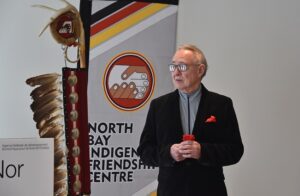North Bay Indigenous Friendship Centre ensures Indigenous flag to fly over North Bay everyday

By Kelly Anne Smith
NORTH BAY— An Indigenous flag will fly in North Bay, Ont., 365 days a year. It will mark the new Miskwaadesi gathering place on the Chippewa Creek EcoPath featuring a petroform of a 20 ft. turtle. The North Bay Indigenous Friendship Centre project is one of five announced by Canada’s Speaker of the House on Dec. 16 in North Bay.
Hosted by the North Bay Indigenous Friendship Centre, the media event had Speaker of the House and Nipissing-Timiskaming MP Anthony Rota announcing over $1.3 million in FedNor funding for the Indigenous initiatives. Rota declared, “We are strongest as a region when everyone is thriving.”
Jacob Dayfox sang an opening song and North Bay Deputy Mayor Maggie Horsfield gave a land acknowledgement.
“In the spirit of reconciliation, I wish to acknowledge that the City of North Bay sits on the traditional territory of Anishinaabe peoples and within the lands protected by the Robinson Huron Treaty of 1850, used by the members of Nipissing First Nation. I also acknowledge the nearby Anishinaabe communities of Dokis First Nation and Temagami First Nation.”
President of the North Bay Indigenous Friendship Centre Maurice Switzer explained the Miskwaadesi is Anishinaabemowin for painted turtle. Switzer says it is the name of a reconciliation and learning project in which an amphitheatre with seating will be constructed and a traditional medicine garden will be planted.
“There are 13 natural rocks that form the scute on her turtle back that represents the 13 lunar cycles of a calendar year. The 28 platelets around the outside represents the number of days in a lunar month. That’s a calendar,” he explains. “It will be a teaching place for not just Indigenous peoples to celebrate our culture, but for other people to learn about our culture. One of the things they will learn about is the fact that we are in Treaties… When I drive around North Bay, I see flags flying on masts that represent Britain, Franco-Ontarians, Italy – to my knowledge, none of those communities have Treaties.”
Switzer says there are over 8,000 Indigenous citizens in North Bay and despite repeated attempts, there was difficulty getting an Indigenous flag flying over North Bay.
“I’m pleased to say that one of the parts of the Miskwaadesi project is a flagpole to fly, 365 days a year, a flag showing that this is our traditional territory. It’s very important to us. It is a very important symbolic thing.”
The petroform is going to give the appearance of a large, female turtle coming out of the creek, detailed Switzer.
“There will even be little seven eggs behind her. The turtle for many Indigenous peoples in this country, particularly the Anishinabek and the Haudenosaunee, is very important symbolically. As part of our Creation Story, we are taught that Turtle Island or what we call North America, was formed on the back of a giant turtle.”

Nipissing First Nation Councillor Jane Commanda, of the Eagle Clan, thanked FedNor for the support of the new commercial cold-climate growing modules as the Mnogin Greenhouse Manager Makenzie Jones looked on.
“Food security continues to be a challenge for Indigenous peoples and organizations across Canada. First Nations, particularly in the north, need to become much more self-sufficient in growing our own food. The former Economic Development Manager at Nipissing sparked an idea of a potential business venture to provide a new way to look at food sovereignty while promoting healthy eating and wellness. That’s how the Mnogin Greenhouse came to be,” she explains. “Mnogin means grow well. Mnogin Greenhouse not only addresses the need to provide healthier and better food security for our members, but it will also develop the capacity to grow our own fresh produce year-round; will provide economic benefits for the local markets; combat climate change and reduce huge carbon footprints; and diversify Nipissing First Nation’s economy.”
Councillor Commanda added, “I think it’s wonderful they are supporting five projects today. I’m looking forward to having the projects completed and having the Mnogin Greenhouse up and running and providing food for the region.”
The other projects include through the Temiskaming Native Women’s Support Group, the Keepers of the Circle Centre in Kirkland Lake will create an outdoor space for Indigenous people for gatherings, celebrations, and a land-based education site modelling sustainable land use and renewable energy systems. This project is expected to create six new jobs.
Temagami First Nation will hire an Economic Development Officer to build business development. The project is expected to create 40 new jobs and a community economic development organization.
The Anishinabek Nation will revitalize the Anishinabek Nation Economic Blueprint, stimulating economic development opportunities for the 39 member First Nations. Current data of the Anishinabek First Nations and the Ontario economy will be sought while creating regional strategies for developing business plans and ventures.


